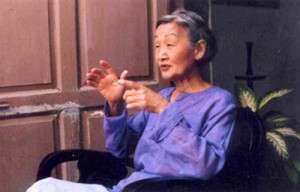Korean-American documentarian Dai Sil Kim-Gibson opens Motherland with her own voice relating how her feeling of homelessness in her “adopted home,” the United States, led her to Cuba. There she meets Martha Lim Kim, a second-generation Korean-Cuban, and talks about Korea–the home of the past for both–and Cuba and US, their current homes. The conversation continues with Martha’s family and other Korean immigrants in Cuba. Their general pro-Revolution stance provokes Kim-Gibson to interview Korean immigrants in the US who fled Cuba after the Revolution. Their belief in the American dream and antagonism toward Cuba, inherited by their US-born children, makes Kim-Gibson look back to Cuba. At the end of the film, between the two (or three) countries, she seems to have found an answer that is not bound to any one country.
Although Motherland starts with a personal history, soon it becomes clear that the personal search for home inevitably coincides with political histories. Kim-Gibson, born in 1938, started her journey from her homeland North Korea to South Korea for “democracy” and then to the US for education, while Martha’s father fled Mexico to Cuba, where the revolution has accepted Martha and her children as true Cubans. The subject of Korean-Cubans branches from the documentarian’s interest in the less known peoples of the Korean diaspora such as the Sakhalin Koreans (A Forgotten People, 1995), the choice of this subject and her way of approaching it reflect her political frustration in the US.
Visual narration is as informative as the voice-over narration and interviews in Motherland. First, the documentary is bookended with shots of the filmmaker herself, first in Havana and in the end on the Brooklyn Bridge, providing a frame for the personal stories that share a common root, extend to three distinct countries, and interact with each other. The images of traditional Korea that accompany Kim-Gibson’s introduction to her personal history are followed shortly after by the shot of Martha in her traditional Korean dress. While these images project Korea as a place of the past, the houses of Martha and her sister reveal the recent history intertwined with their respective personal narratives. Martha’s house, a remainder/reminder of the colonial and capitalist Cuba, is compared with her sister’s house in Miami—a token of the middle-class, multiethnic American life. In addition to Kim-Gibson’s own footage, photographs from archives and family albums, as well as video records of historical events, are used extensively to tell personal stories.
Se Eun Gong 4/15/13


